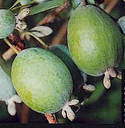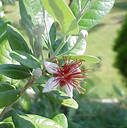All about Feijoa
2) From where does the feijoa originate?
5) What is the nutritional value?
7) How do you know when they are ripe?
The Answers
The fruit is generally ready,depending on the locale,from late summer to early fall and can last up to early November during some years.
2) From where does the feijoa originate?
It has been said that the feijoa originated from the highlands of southern Brazil and parts of Colombia,Uruguay and northern Argentina.
The fejoa is a small evergreen shrub or small tree1–7 meters (3.3–23 ft) in height.they make a lovely garden ornamental as the flowers are very beautiful and edible.
The fruit is usually eaten by cutting it in half, then scooping out the pulp with a spoon.The fruit have a juicy sweet seed pulp, and slightly gritty flesh nearer the skin. The flavor is aromatic and sweet. If the utensils needed to eat it this way are not available, the feijoa can be torn or bitten in half, and the contents squeezed out and consumed. An alternative is to bite the end off and then tear the fruit in half length ways, exposing a larger surface with less curvature. The teeth can then scrape the pulp out closer to the skin, with less wastage.
A feijoa can also be used as an interesting addition to a fruit smoothie, and can be used to make feijoa wine or cider . It is also possible to buy Feijoa yogurt, fruit drinks, jam (very good), ice-cream, etc. in New Zealand. The Feijoa can also be cooked and used in dishes where one would use stewed fruit. It is a popular ingredient in chutney. The flowers are are also edible.
5) What is the nutritional value?
Per 100 grams
Nutrition Facts |
| Serving Size 100 grams |
| Calories 49 |
| Total Fat 0.78g |
- Saturated Fat g |
- Monounsaturated Fat g |
- Polyunsaturated Fat g |
| Cholesterol 0mg |
| Sodium 3mg |
| Total Carbohydrate 10.63g |
- Dietary Fiber g |
- Sugars g |
| Protein 1.24g |
| Vitamin A 0 |
| Vitamin C 20.3 |
| Calcium 17 |
| Iron 0.08 |
It is a warm-temperate sub-tropical tree that will also grow in the tropics but requires some winter chilling to fruit and is frost tolerant. It has been cultivated as far north as western Scotland but does not fruit every year, as winter temperatures below about −9 °C (16 °F) will kill the flower buds. Large quantities are grown in New Zealand, where the fruit is a popular garden tree and the fruit is commonly available in season. California is another ideal location where they are planted in orchards and also as garden ornamentals.
7) How do you know when they are ripe?
Easy, you don't pick them.You wait until they drop off the tree,or fall into your hand at the slightest touch .Farmers will cushion the fall by laying burlap or straw under the tree to prevent bruising.

